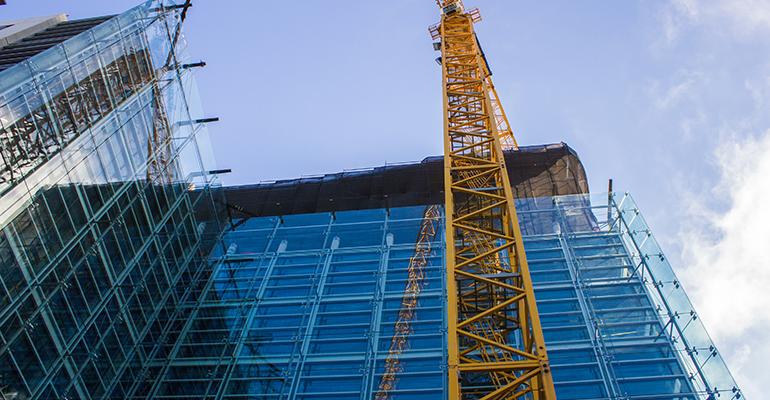While new office construction has been robust so far in 2018, next year developers might begin pulling back, according to David Bitner, head of Americas capital markets research with real estate services firm Cushman & Wakefield. He cites rising construction costs, concerns about the end of the real estate cycle and zoning issues as the reasons.
In the first two quarters of 2018, the U.S. office market experienced the influx of 28.8 million sq. ft. of new space, according to Cushman& Wakefield. This was higher than the amount of new space delivered during the same period in 2017. By year-end, new office deliveries should reach 68.4 million sq. ft. “Developers are playing catch up now,” says Bitner. “The last three cycles had a lot more construction relative to inventory.”
Bitner expects developers to begin pulling back in 2019, with 54.7 million sq. ft. in new office deliveries projected for the year. This figure is based on projects under construction, which take approximately two years to complete.
So far, tenant demand for new, quality office product seems insatiable, Bitner notes, with most of the leases in central business districts (CBDs) being signed by technology, financial services and law firms. In the second quarter of 2018, almost 60 percent of all office space that was delivered to the market was leased at the time of completion, according to Andrea Cross, Americas head of office research with real estate services firm CBRE. About half of the space currently underway has been pre-leased, she adds, noting that pre-leasing rates are even higher in some of the most active markets. For example, in San Francisco, Washington, D.C., Seattle, Dallas/Ft. Worth and San Jose metro areas, between 55 percent and 67 percent of the office space under construction has been pre-leased.
“Due to the moderate rate of the current office expansion and rising construction costs, development has been concentrated in markets and submarkets where tenant demand and rent growth have been strong enough to justify it,” Cross says.
According to CBRE, the top five markets for office construction currently include: Manhattan, with 16.69 million sq. ft. of space; San Francisco, with 8.50 million sq. ft. of space; Washington, D.C., with 7.46 million sq. ft. of space; Seattle, with 5.53 million sq. ft. of space; and Dallas/Ft. Worth, with 5.11 million sq. ft. of space.
In addition, the south continues to see the largest share of new office space deliveries, at 35 percent of the total year-to-date, according to Bitner. But activity there is winding down compared to earlier in the real estate cycle, when markets in the south accounted for nearly half of all deliveries.
When asked if any markets are at risk of overbuilding, Christian Beaudoin, director of research and strategy with real estate services firm JLL, cites Nashville, Tenn. Because its office space absorption is dependent on continued population and job growth. Westchester County, N.Y. and Fairfield County, Conn. are other areas of concern. Bitner also cites Houston, Northern Virginia, San Mateo, Calif. and Brooklyn, N.Y., because of the number of years it will take to absorb new product based on these markets’ absorption rates.
For example, based on its absorption rate, it will take Brooklyn 10 years to absorb the 2.5 million sq. ft. currently under construction in this market.





